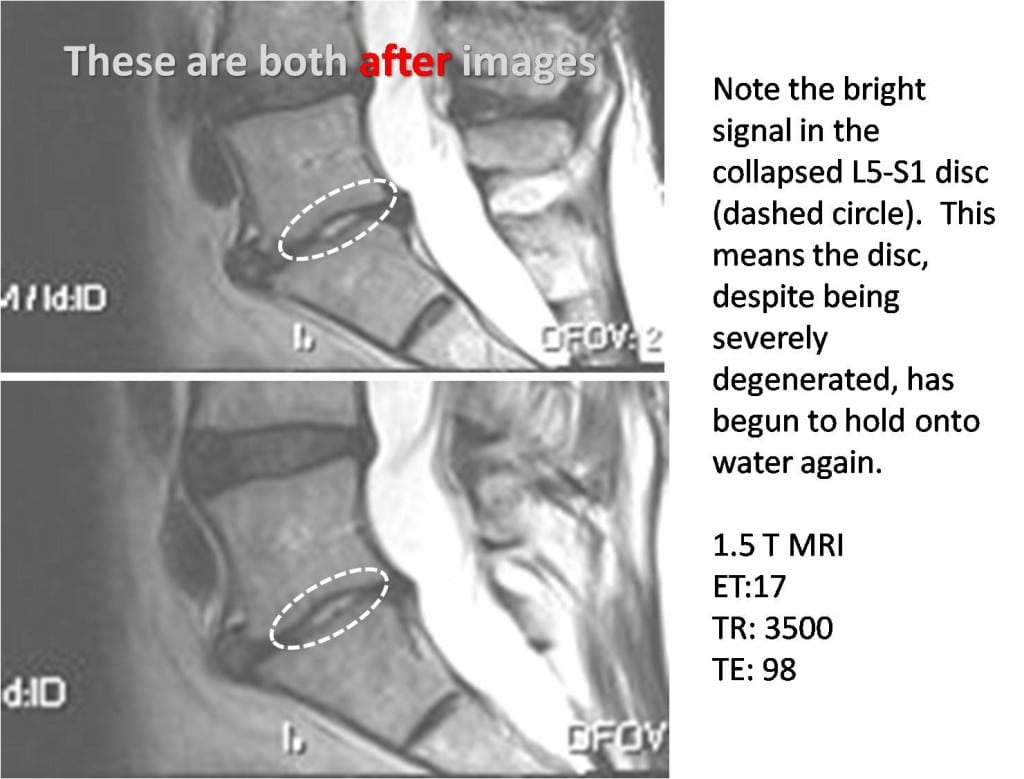New Research on Stem Cells and Degenerated Discs
The title of the paper kind of hits you, “Mesenchymal Stem Cells Arrest Intervertebral Disc Degeneration…”. This past week Chinese researchers published a paper showing that the same stem cell line being used in the Regenexx-C disc procedure can stop the natural progression of spinal discs from degenerating. This is similar to other papers showing that show that low back disc regeneration is also possible. You see, once a disc is injured, it invariably seems to become worse and worse (degeneration). First it looses it’s ability to hold onto water, going from bright on T2 MRI images to dark. After this, it eventually starts to collapse, so that at some point it’s “bone on bone”. The Chinese showed that an injection of stem cells into the disc stopped this “sure thing” worsening (Intervertebral Disc Degeneration). We also had some results this past week that would support this Chinese finding. We have known for some time that we can help many patients get rid of disc bulges that are pressing on nerves by injecting their stem cells into the disc. However, we have always limited our patients to those where the disc had yet to collapse (good disc height). In February we treated a patient with an old 2007 MRI showing a dark, dried out disc with reasonable disc height and a disc bulge. By the time of her stem cell reinjection, it was clear on the fluoroscopy image that her disc had progressed and collapsed. Dr. Schultz and the patient decided to proceed with the stem cell injection as she wanted to try to save the disc and didn’t want surgery. She reported excellent relief of her back and leg pain, so we were curious to see what had happened with that collapsed disc.

The pictures above are all “AFTER” images (we usually show before and after). Her old films are only in hard copy, so I haven’t been able to pull those yet. In addition, they wouldn’t help much, as they show a dark disc with better disc height two years before the stem cell injection, before it had collapsed. What’s exciting is the white area inside the L5-S1 disc that shows that this disc is now holding onto water. Why is this important? As stated above, low back discs are living tissue that have cells that produce chemicals that hold onto water. It’s these chemicals that allow the low back discs to act as shock absorbers. Think of those super absorbent baby diaper chemicals that can hold many times their weight in water. Once those cells start to die off, they aren’t there to produce the chemicals to hold onto water and the disc gets dark on this type of MRI (look at the dark, untreated disc above the one with the dashed circle). These dried out and dark discs are really bad shock absorbers, so the surrounding bone gets beat up and in response, your body adds bone spurs. Once your body adds bone spurs to shore up the beat up bone, these spurs can press on nerves and then it’s big surgery (foraminotomy and/or laminectomy). So the fact that her problem disc is now holding onto water, means that this disc may be able to act as a shock absorber to prevent the formation of bone spurs. This is exciting stuff. Note that we didn’t recreate a brand new disc, so there is still the need to treat patients early before the disc collapses. However, the fact that we could likely add some function back to a collapsed disc means that for these patients, all hope may not be lost.
This patient was treated with the Regenexx-C (cultured stem cell injections). Not all low back patients can expect to get these same results.

If you have questions or comments about this blog post, please email us at [email protected]
NOTE: This blog post provides general information to help the reader better understand regenerative medicine, musculoskeletal health, and related subjects. All content provided in this blog, website, or any linked materials, including text, graphics, images, patient profiles, outcomes, and information, are not intended and should not be considered or used as a substitute for medical advice, diagnosis, or treatment. Please always consult with a professional and certified healthcare provider to discuss if a treatment is right for you.